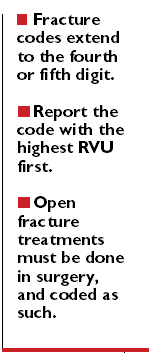Article
Coding Consult
Fractures

Keep an eye on fourth and fifth digits "Incorrect diagnosis coding is one of the primary reasons for claim denial in fracture care," says Elisabeth P. Fulton, coding and auditing department supervisor at Orthopaedic Specialists of the Carolinas in Winston-Salem, NC. When coding fractures, you need to be as specific as you can with your diagnosis codes, she adds.
Fracture codes extend to the fourth or fifth digit, depending on the diagnosis. The fourth digit indicates whether the fracture is open or closed; the fifth digit indicates the specific location of the fracture. For example, you would report 812.21 (fracture of humerus; closed; shaft of humerus) for a patient with a closed fracture in the shaft of his humerus. The fourth digit "2" indicates "shaft or unspecified part, closed" and the fifth digit "1" shows the more specific location "shaft of humerus."
And when you code multiple fractures at one time, report the fracture care code with the highest physician work relative value unit first. You want the highest dollar value to go first on your claim because the multiple surgery rules will apply: The carrier will pay the first procedure at 100 percent and the second and subsequent procedures at 50 percent of their allowance, says Michelle Logsdon, a consultant in Brick, NJ.
So, for the above scenario, you'd report the following diagnosis and CPT codes:
Be aware of V codes Although many offices tend to ignore V codes, they can be useful for follow-up fracture care visits because they paint a clearer picture for the carrier of the patient's complicated condition, says Fulton.
The ICD-9-CM manual lists fracture aftercare codes that you should report for subsequent visits after the patient's initial fracture care, says Margie Vaught, a coding consultant in Ellensburg, WA. When coding follow-up visits, report code V54.1x (aftercare for healing traumatic fracture) for a fracture that results from a trauma-such as rolling an ankle or hitting a toe-and use V54.2x (aftercare for healing pathologic fracture) for a fracture caused by conditions such as a bone lesion or arthritis.
Don't report V58.43 (other aftercare following surgery; aftercare following surgery for injury and trauma) unless a patient is receiving treatment for a healing traumatic fracture (V54.1x) and for other injuries as well.





